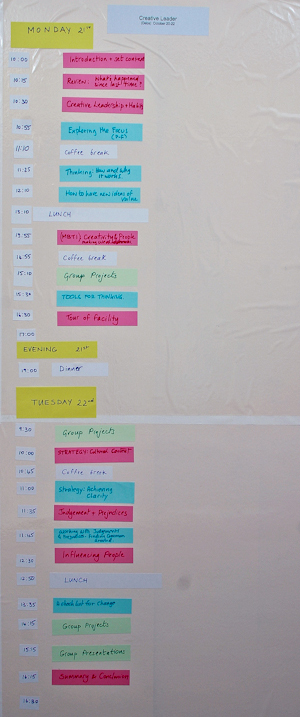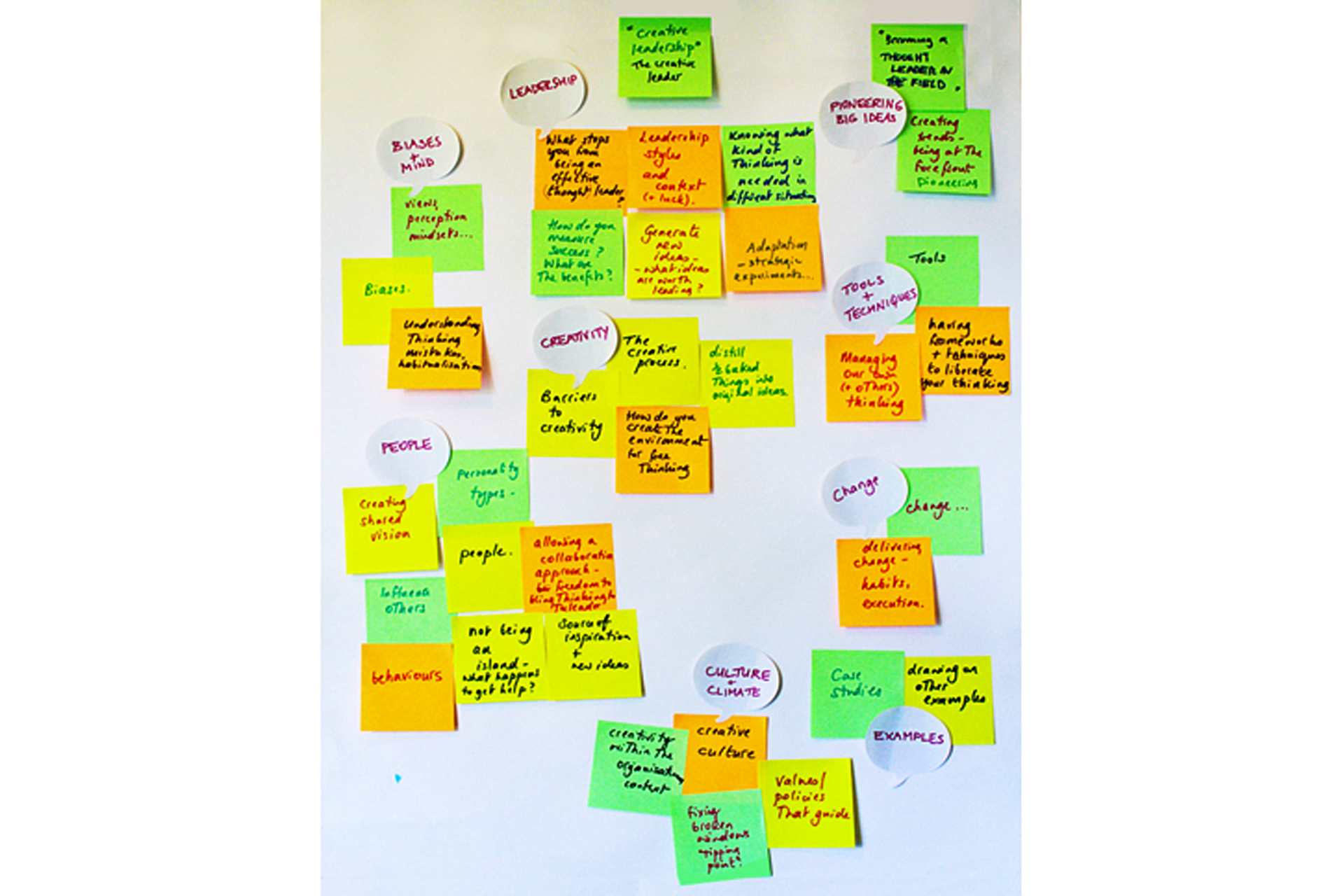You know what they say: “It’s been a journey”. I say it glibly, with my tongue firmly placed in my cheek. This saying, (familiar to most for all the wrong reasons) has become very clichéd since the likes of X Factor and other similar Saturday night TV talent shows have claimed it for their own. Never one to want to run with the crowd, I hold my breath and say instead: “Maybe, I have grown – no that’s not it…hmmm – I think I have learnt a lot!”
Let me set the scene. It is mid-May 2013. Imagine if you will, my thought processes. I am trying to bring to life an idea that has been germinating in my mind for more than a year, about how to invigorate the core Leadership programme for developing the managers of our organisation. There seemed to be something missing from our development mix, some skills these people needed that we hadn’t covered, but I couldn’t put my finger on what these were.Thought Leaders?
I had bandied around the term “Thought Leadership” loosely, thinking “Yes, that’s what we need: we need our people to be thought leaders”. I said this as if I knew intrinsically what it meant and how I could bring it to life for them – but neither was true. Thought Leadership was a term that had enticed me during my time at The Co-operative, where it had been used liberally. But having researched it further, I am guessing that, actually, no one had really known what it meant. It sounded impressive though and I felt it might be the missing ingredient I was looking for, so I wanted to explore it further.
Curious as ever, I looked up the source. The term “Thought Leader” was coined in 1994 by Joel Kurtzman, Editor-in-Chief of the Booz Allen Hamilton magazine Strategy & Business, and was used to designate interview subjects for that magazine who had business ideas which merited attention. The problem with this definition was that it was so broad and open to interpretation. You could almost say that it was an extension of the concept of the “entrepreneurial spirit” – how could we make a course out of that? In the absence of a clear idea of what a thought leader might look like, I searched far and wide for a two day course on the topic of Thought Leadership, but they were thin on the ground – almost none existed.
Moving Hearts and Minds: Robin Ryde
I did, however, find an interesting individual who seemed to be a lone voice in the field: Robin Ryde. He had written a book entitled Thought Leadership: Moving Hearts and Minds. I downloaded it on my Kindle and read it with a ferociousness that meant I was hoping to find something spectacular. Startlingly, there was nothing new here; this was not revolutionary stuff, just a simple framework for thinking laterally. It was useful, the book was well written and designed to be dipped in and out of, but still there was no one leading me by the nose to that light bulb moment that I so craved. Robin had categorised his book into sections related to thinking styles, things that get in the way of our thinking and the mists that cloud us when we think about a problem or tackle a task. His premise is that leadership is about transforming the thinking of people around you, thinking about problems, possibilities and capabilities. He writes:
“Anyone interested in change or leadership needs to understand what is going on in the thinking process…why sometimes when people come together great things happen, and on other occasions it seems like a shocking waste of time, money and energy”.
Robin subdivides thinking into 7 discernible categories or channels: deficit, rational, sticky, common sense, binary, and equity thinking. As a thought leader he is seemingly using his theories to underpin separate thinking processes, but he also pulls this together in a palatable way which allows the reader to understand what might get in the way of the creative process. What I did find was that Robin’s theory was similar in its approach to the work of Edward de Bono who invented the term “Lateral Thinking”. Ryde talks of being stuck in channels of thinking and de Bono’s Lateral methods are about moving out of, and across those channels. De Bono has written over eighty books outlining practical tools and methods to do what he calls “Operacy: thinking for the purpose of doing”.
Blazing a Trail
Suitably armed with Edward’s understanding, coupled with some of Robin’s ideas, I approached my fellow Thinking Utopians and experienced facilitators Sophie and Adrian of Company of Mind to assist me in my challenge. It seemed like a good place to start. We wished to blaze a trail for “Thought Leadership” when, in a front room in Manchester, we three set about designing the two day programme to fit into my current leadership development offering. It was also our first joint training venture.
Let me tell you how this came about. I inherited a wonderfully written year-long leadership programme which I happily ran in 2012 with twelve knowledge-hungry delegates. There was, however, something that I felt we could add to this offering to enhance the delegates’ experience. We had asked them to look inwards using feedback and personality type; we asked them to look outwards at the business and undertake a change project; we looked at Lean processes and the Kaizen school of thinking and how people responded and behaved during periods of change. But we didn’t really equip them with the skills to create groundbreaking ideas that could revolutionise the business. This was where we began.
Thinking as a skill
Adrian observes: “We’ve asked thousands of doctoral students if they have ever had any formal training in how to think, and even for those at the top of our educational system, the answer is almost none.” So we teach reading, writing and arithmetic in our schools but we don’t explicitly teach people to think. A truism I believe, like no other.
Sometimes I think we are all guilty of making new problems fit the mould of our established experience. This is why our solutions look familiar to those who know us, and we learn again to our surprise that “if we always do what we always did, then we always get what we always got” – how frustrating! Yet if we try to grope for genuinely new approaches we hear comments such as “The problem with you is that you over-think things” – as if thinking is not a desirable attribute to possess. Given these enduring work-culture barriers it’s no wonder we had a hill to climb when designing a course that would work. And it’s no wonder that the academic writing and theories on this subject are rather sparse.
Our goal for this two day programme was to create leaders who could think differently; to develop leaders who didn’t get stuck in ruts creating the same solutions over and over again; who recognised the need to stand back, and had many tools at their disposal to come up with solutions to their very real problems in order to pioneer change.
Designing and delivering our new course
The design of the two days had to be interactive and cover accessible models and ideas that could be implemented back at the ranch. So we set about designing a course to encompass all that is was to think and how that process might benefit any organisation and move it forward.
We explored all the areas we imagined we wanted to cover, gathering notes on post-its as we did so and then “affinity grouped” them. From here it became satisfyingly clear, as we highlighted each group with a top level heading, what themes we needed to include. We went on to map out the two days in detail. The focus of the first day was to be on principles, tools and techniques, whilst Day 2 was angled towards application in practice. Between us we then worked up content, exercises, slides, visuals, worksheets, handouts and gathered props, excitedly looking forward to co-delivering the freshly-designed material in late October.
In the two days we covered a lot of ground. We introduced tools and techniques to open people’s minds. We focused on perception, on culture and strategy, and delivered a range of creative thinking techniques. We moved people’s thinking from ‘sticky thinking’ to effective thinking. We included some “Thinking with your hands” too – which I knew my delegates enjoyed – in order to create innovative solutions. After all, as Heraclitus, the ancient Greek philosopher, said “We learn best when we are at play” – an idea current today in the work of, for example, Stuart Brown. They then applied their learning to real problems, working in groups, and finally once they had created “their great idea” we introduced them to some thinking frameworks to give the process structure and rigour to ensure that their ideas could fly and gain traction in the workplace.
Reflections
The delegates? Well they, understandably, had a ball, (as did we) and their takeaways were rich and immeasurably valuable to them. Reflecting on it, we have an immense sense of satisfaction, as what was offered was taken with good grace and an open mind and the participants are now working with their key learnings to become strong creative leaders. What are our takeaways? Well, the long-imagined course on “Thought Leadership” – now more aptly titled “The Creative Leader” – exists in real time both for our programme and as a stand-alone workshop. We also have a much clearer definition and understanding of what, at least for us, leading our thinking really means, and we hope our coming together has prepared the ground for “great things to happen”.
We’ll hear more about the content of the course in our next blog.
Debs Barker and Sophie Brown
References
Robin Ryde
Edward de Bono’s classic book on creativity: “Lateral Thinking: A Textbook of Creativity“, first published in 1970, latest edition 2009.
Stuart Brown’s talk on TED: “Play is more than just fun
